
NPS Photo A glacier is a mass of ice that is large enough and heavy enough to flow, like a very thick fluid. Glaciers form wherever more snow accumulates than is lost each year. As new snow accumulates, it buries and compresses the old snow. Under the weight of the overlying snow, the old snow is transformed from a fluffy mass of ice crystals into dense, hard ice. This process occurs on the upper part of the glacier, at higher altitudes, where more snow accumulates than is lost each year. This is called the accumulation zone, and is typically covered in snow year-round. The glacier is in constant motion as the ice in the accumulation zone flows down to lower altitudes, into what is called the ablation zone. The ablation zone is the lower part of the glacier where more snow is lost than accumulates. In late summer, when the seasonal snow has melted away from the surrounding valley walls, bare ice of the ablation zone is exposed. All glaciers have accumulation and ablation zones. The boundary between between these two zones, the equilibrium line, is the transition where accumulation equals ablation (the same amount of snow accumulates as melts each year). The accumulation zone has three major layers. The top layer is snow. The middle layer is the firn, a transitional form between the snow and the solid ice below. The bottom layer is ice. As the glacier flows downhill, the top snow layer flows faster than the bottom ice layer, which grinds and scrapes across the mountain's rocky surface. 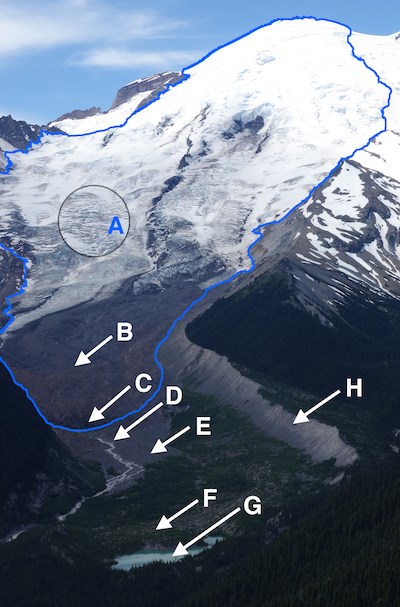
NPS Image. Anatomy of a GlacierThe blue outline marks the edges of the Emmons Glacier, located on the eastern slopes of Mount Rainier and viewed from the Emmons Vista Overlooks at Sunrise. Letters pointed out on the photo mark out different glacier features.
A) Crevasses are cracks and breaks in the glacier ice, formed as the ice moves unevenly over the slopes of Mount Rainier. The circle around "A" shows a magnified view of a small portion of the crevasses on the Emmons Glacier. B) Rock debris covers the lower portion of Emmons Glacier. Much of this rock came from a large rock fall in the 1960s. The rock layer helps insulate the glacier's ice from melting and is believed to have contributed to an advance of the Emmons Glacier for a time after the rockfall. C) Terminus, or end, of the glacier. D) Water from melting glacial ice leaving the terminus of the glacier. The melt water from the Emmons Glacier is the source of the White River. Streams flowing from glaciers are clouded with fine sediment, called glacial flour, created by the glacier grinding its rocky bed. The glacial flour gives the water a milky color. E) Outwash Plain, filled with sediment, rocks, and other debris left behind behind the retreating glacier. Outwash plains are further shaped by the glacial meltwater streams, forming braided river beds through a process called aggradation. F) Terminal Moraine, a large ridge-like formation of rocky debris left behind by the terminus of the glacier as it retreats. Terminal moraines like the one indicated here mark places in the valley that the glacier extended to in the past. G) Glacial ponds can form if glacier ice broken off the main glacier melts and the water is captured behind a moraine. Terminal moraines can also dam the valley, causing melt water to pool. H) Lateral moraines are debris ridges forming along the edges of the glacier instead of at the terminus. The large, steep lateral moraines near the Emmons Glacier indicated here were left behind by much larger, ice age glaciers that predated the Emmons Glacier. 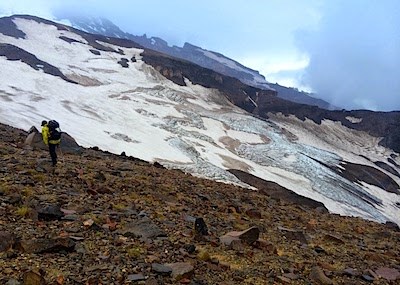
NPS Photo Types of GlaciersMost of the glaciers on Mount Rainier are known as valley glaciers. These glaciers are confined to a valley. Three good examples of this type of glacier are the Nisqually, Carbon, and Emmons glaciers. The smallest glaciers on Mount Rainier are cirque glaciers. These small glaciers occupy a bowl-shaped basin at the head of a mountain valley. Cirque glaciers are usually the remnants of much larger valley glaciers. Examples of this type of glacier are the South Tahoma and Inter glaciers. Another type of glacier, called a continental glacier, is a large ice sheet that covers thousands of square kilometers. Although there are no continental glaciers in the Mount Rainier area today, 15,000 years ago much of the Puget Sound west of Mount Rainier was covered with a continental glacier over 3,300 ft (1,000m) deep. At least one of the current glaciers on Mount Rainier may have been a tributary of this ice sheet. 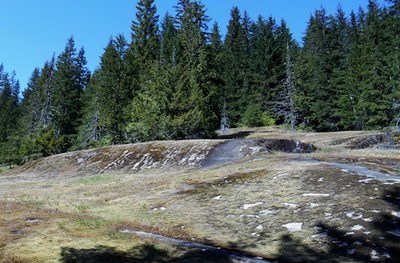
NPS/Anne Spillane Photo Additional Glacier FeaturesA roche moutannée, or "sheep-rock", is an elongated, glacially scoured bedrock bump or hill with a distinctive shape that supposedly resembles the back of a grazing sheep. The rock formation has a steep, rough side produced by glacier plucking and a low angle, polished and striated side created by glacial abrasion. As glaciers flow downhill they pluck rocks from the surface under the glacier by either freezing on to them or by breaking them off ledges. The plucked rocks are dragged by the moving ice over the rock remaining in place. The rock-studded ice acts like sandpaper to grind the bedrock. Roche moutannées can be viewed around Mount Rainier below the Paradise Glacier, or along the trail near Box Canyon. 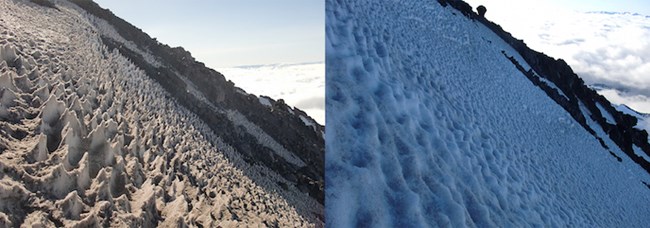
NPS/Forrest Madsen Photos Penitentes, pictured left, are one type of snow formation that can form on Mount Rainier's glaciers. Penitentes are pinnacles of snow that can be several meters tall. They appear on the upper mountain, typically during summer months. At high elevations during the summer the air remains cold and dry but there is an abundance of bright sunlight. The strong sun exposure causes snow crystals to transition directly into water vapor without melting first. This process is called sublimation. As the surface of the snow forms depressions, the curved shape reflects and concentrates the sunlight further, speeding up the process of sublimation and eventually forming a forest of snow spikes. Sun cups, pictured right, are shallow "cup" like hollows in the snow's surface that are also created through exposure to strong sunshine. While sun cups can be created through sublimation, they can also form due to melting. They are typically smaller than penitentes and can occur at lower elevations. 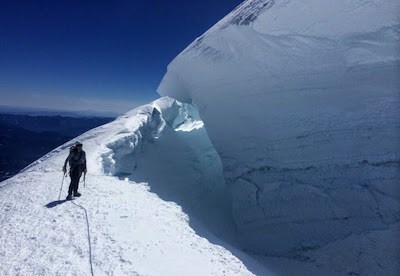
NPS Photo A bergschrund is a large, often deep, crevasse that forms at the upper end of a glacier. Sometimes a bergschrund forms between a lower portion of active glacier and an upper portion that has stopped flowing and become stagnant ice or snow. Mount Rainier also has bergschrunds where the glaciers break off from the summit, as pictured here. 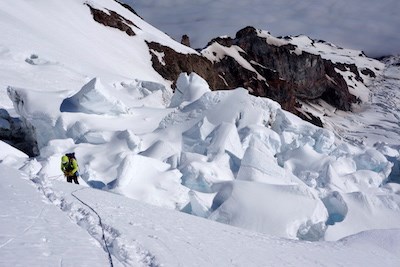
NPS/Forrest Madsen Photo Seracs are large blocks or columns of glacial ice created when crevasses cross each other. The large pinnacles of ice can collapse unexpectedly, which combined with the broken surface terrain, makes seracs very dangerous for climbers. 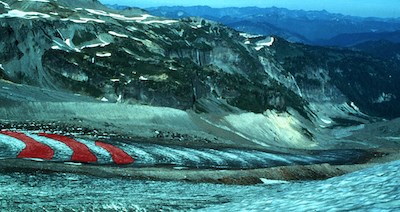
NPS Photo Ogives are alternating bands of light and dark ice on a glacier. As the glacier flows over a rock ridge or other feature that creates an ice fall, the surface of the glacier cracks and forms crevasses. The walls of the crevasses collects dust and dirt when exposed (typically in summer), turning the ice darker. Each darker ridge of ice corresponds to a year of the glacier's growth. Ogives are rare on Mount Rainier but can be seen in the combined lower portion of the Cowlitz and Ingraham glaciers. 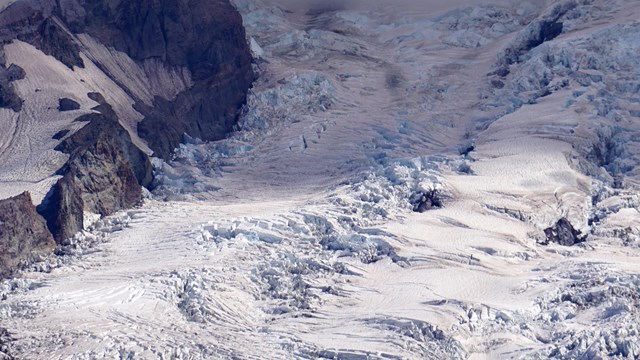
Mount Rainier Glaciers
Map and descriptions of some of Mount Rainier's major glaciers. 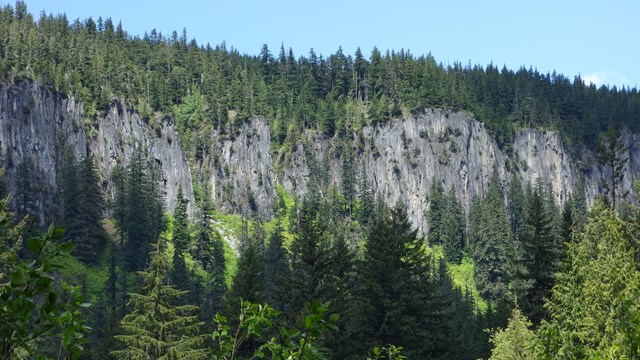
Geologic Formations
Explore Mount Rainier's geologic history through this selection of geologic formations. 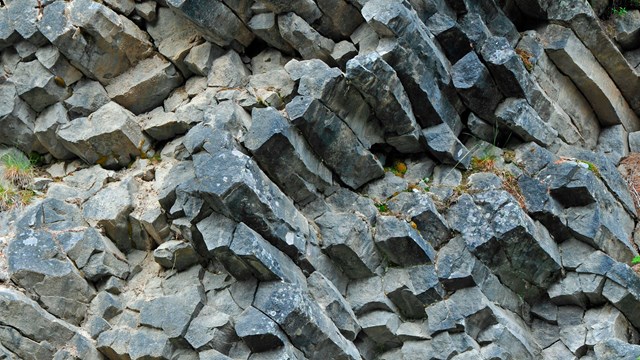
Volcanic Features
Mount Rainier is a volcano and many volcanic features can be found in the park. |
Last updated: March 20, 2025
